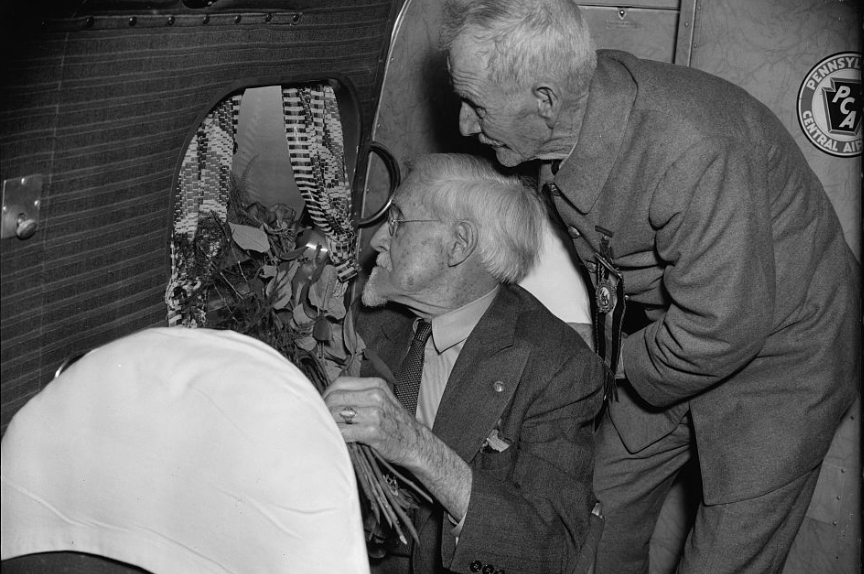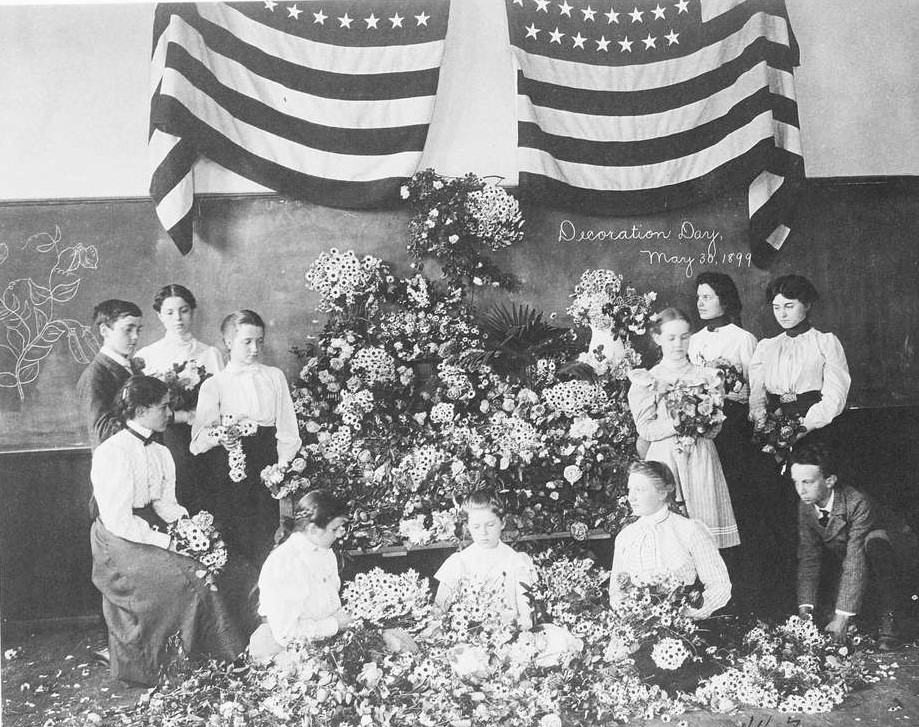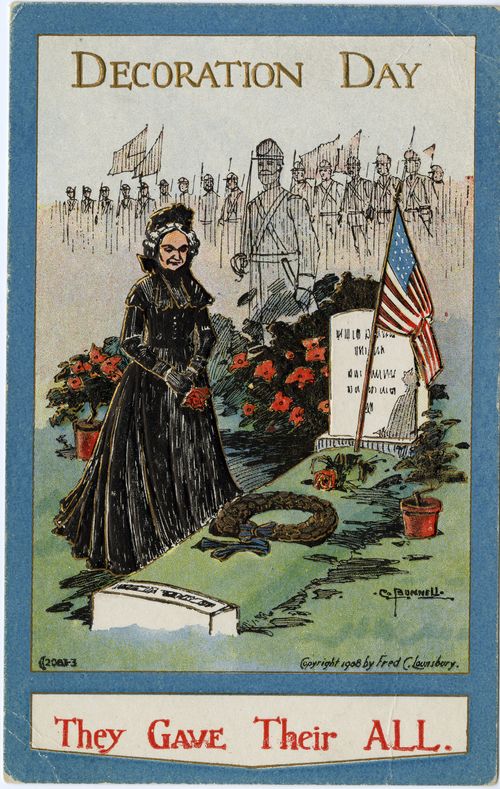Year by year the ranks of the Grand Army of the Republic grew thinner — but until the last old soldier was gone, Decoration Day in a New England town was a moving memorial to “the War”
-
April 1971
Volume22Issue3

The War had been over hardly two decades when I was a boy. If one had occasion to refer to it, he called it simply “the War,” for it was the only war we had had within the memory of all but a negligible few. School books like John Fiske’s History of the United States called it “the Civil War.” Histories for adults called it “the Great Rebellion.” To call it “the Rebellion” in a school book would have confused the pupils, who would have found it hard to distinguish, between “Rebellion” and “Revolution.” In fact, years later I came upon a student at my university who thought them one and the same war. “The War Between the States” hadn’t been coined, and it still sounds odd to nineteenth-century ears.
Our New England town had erected a Memorial Hall of brick with stone trim to honor its sons who had taken part in the conflict. On bronze mural tablets in the foyer are the names of those who lost their lives and of the battles in which they fell. On pedestals, one on each side of the wide flight of granite steps leading to the main entrance, stand heroic bronze statues by a now-forgotten sculptor—the one on the left, a soldier with his musket, standing at parade rest; the one on the right, a sailor, his right hand on the hilt of his cutlass, his left resting lightly on his hip. But what I liked best as a young child was the fieldpiece, a ponderous memento of the great struggle that stood on the lawn before the hall, aimed pointblank at the stores on the opposite side of Main Street. It was my delight to clamber over this monstrous relic or to sit astride its barrel, now forever silent.
In 1868 General John A. Logan, Commander in Chief of the Grand Army of the Republic, issued a general order designating May 30 of that year “for the purpose of strewing with flowers or otherwise decorating the graves of comrades who died in defense of their country during the late rebellion and with the hope that it will be kept up from year to year.” This proposal met with approval by a public that still felt the loss of loved ones. Thereafter, May 30 was known as Decoration Day, until in 1882 the Grand Army urged that the proper designation of May 30 is Memorial Day. By that time, however, the term “Decoration Day” was fixed in the popular vocabulary, so that even now, those of my generation still use it.
In any case, by whatever name the day might be called, it belonged to the Veterans. All business was suspended. Stores, offices, and factories were closed. School did not keep. In fact, everything was at a standstill. Flags flew from all public buildings and from very many private dwellings.
On the last day of school before Decoration Day, in all classrooms there were “exercises.” Boys and girls from the smarter half of the class recited “The Blue and the Gray,” “O Captain! My Captain!” “Sheridan’s Ride,” and “Barbara Frietchie.” In the ninth grade the smartest boy recited the Gettysburg Address. The parents of those pupils who took part attended the exercises, sitting at the front of the room, to the discomfort of their offspring. The class as a whole sang “The Battle Hymn of the Republic,” “Tenting Tonight,” “Columbia, the Gem of the Ocean,” and “America” —“God Bless America” and “America the Beautiful” were yet to be composed. There was always a Veteran sent by the local Grand Army post to speak to us about loyalty, patriotism, and other abstractions. One of these had actually seen, with his very own eyes, the Great Emancipator himself. When the Veteran had spoken, the prettiest girl in the class, dropping a curtsy, presented him with a nosegay, which he awkwardly accepted. Then the class sang “The Star-Spangled Banner,” and school let out for the day.
I used to wish that these speakers from the G.A.R. post would tell us about the War and what it was like to go into battle, but this never happened until some years later, when I was a student in high school and all four classes assembled in the auditorium for the exercises. By then the Veterans were getting old.
On that occasion, when the G.A.R. speaker rose from his seat on the platform and advanced stiffly to the lectern, his face was flushed and his eyes wore an inward look as though his thoughts were far away. To my delight he launched into a series of personal recollections— of marches and bivouacs, of advances and retreats under fire, of bayonet charges and hand-to-hand fighting. His memory was still clear; in fact, he seemed to have the faculty of total recall, and as he warmed to his subject, his imagination took fire. For upward of half an hour he ran on, while the principal, a gentleman and a scholar of the old school, grew more and more uneasy. Pointing his finger at the freshmen, who sat in the front rows, the speaker declared that were he to lead a company into battle, he would choose to lead just such youngsters as these. At length he stopped abruptly, turned about, and made his way a trifle unsteadily back to his seat. Of the many Decoration Day speeches that I listened to in my school days, this is the one I remember.
In the afternoon and evening before Decoration Day the wives arid daughters of the Veterans, who constituted the ladies’ auxiliary of the post, assembled in the G.A.R. headquarters to make bouquets with which to decorate the graves of the fallen in the ancient town cemetery. People who raised flowers contributed them in great quantities. No doubt the local florists also donated generously as a matter of patriotism and good will. We children brought bunches of wildflowers, hoping to be rewarded with one of the homemade doughnuts that, with coffee, were provided for the workers. The members of the auxiliary corps made the flowers into bouquets and stacked them in wooden washtubs half filled with water, to keep them fresh until the morrow.

On the morning of Decoration Day, which seldom failed to be sunny, the members of the Grand Army post assembled on the steps of Memorial Hall for their photograph. I have before me, as I write, a reproduction of one of these taken about the turn of the century, with about four-score Veterans in the picture. Perhaps the most remarkable thing about it is the disparity in their ages. Some look surprisingly young for men of at least middle age. These must have gone into the War when it was about over, or at an early age—drummer boys were accepted in their mid teens.
These youthful drummer boys were ready-made heroes for the tide of juvenile War fiction that followed the cessation of hostilities. By the time I had learned to read, they were well on their way out of fashion; but such books, tattered and dog-eared, were still to be borrowed at the public library. I believe I read every one there available and derived from them such inspiration that, when our war with Spain came along, I was greatly disappointed that drummer boys were no longer a part of the military.
Of the older Veterans, some look frail and shrunken; others, among whom are many with patriarchal beards or other whiskers, look hail and hearty despite their advanced years. Those intending to march in the parade to the cemetery wear military caps with visors or their soft black felt hats with the Grand Army insignia. The officers are wearing belts and swords. All wear their medals.
After the taking of the photograph the Veterans fell in behind the local fife and drum corps and marched with muffled drums to the cemetery. Those who had become too feeble to march or who suffered from old wounds rode in horsedrawn hacks with tops down, behind the ranks of their sturdier comrades. At the cemetery the Veterans and the women and children placed flowers and new flags on the graves of the former comrades-in-arms. A cast-iron G.A.R. emblem marked each grave permanently. At the plot reserved by the town, on which a monument had been erected “to the memory of soldiers sleeping in unknown graves,” there was a brief service, with the customary three volleys by a firing squad and taps. Then the Veterans marched back to headquarters to the lively tune of “The Girl I Left Behind Me” or “When Johnny Comes Marching Home.”
There was a supper that evening in Grand Army Hall, prepared and served by the ladies’ auxiliary, at which the comrades who hadn’t seen one another for the past twelvemonth got together and recalled almost-forgotten events. It had been their day.
By the time I was old enough to remember, the Veterans had long since become re-established in their respective vocations and were not distinguishable from the rest of the citizenry except on those occasions when they wore their old uniforms. Some, like Henry Childs, who for many years had operated a bookbindery, had retired. Mr. Childs was a regular customer at my father’s tavern; so regular, in fact, that my father had placed a small wooden box in a nook inside the front entrance, where, after his mile walk downtown, the old man might sit and rest and watch the passers-by on Main Street. He was there almost every day for his one toddy; and when I came along with my little toy gun, he seldom failed to put me through the manual of arms.
Many Veterans had become storekeepers, like Alvin Rust, who had had erected on Main Street a three-story brick building, in the ground floor of which he kept a grocery store. But of all these Main Street establishments run by Veterans, the most interesting was the Clark & Parsons drugstore.
George Dexter Clark, whom I knew well in his old age, was a Veteran, as was, I believe, his partner, Mr. Parsons. The latter was in appearance a Victorian gentleman of business, carefully dressed in cutaway and high stiff collar, and dignified in manner. Mr. Clark dressed more casually, wore a stubbly, short red beard, and was of a friendly disposition. Their pharmacy was next door to the Mansion House, the town’s leading hotel. The store had an entrance between two show windows, in each of which was a huge glass globe of colored water, one red, the other blue—the signs of a drugstore in the nineteenth century.

Within on the left was a handsome pink marble soda fountain, with half a dozen high stools before it. Except for this concession to the times the store was devoted to the proper business of pharmacy. It was entirely free of the innumerable articles that clutter the modern drugstore. There was not even a rack for magazines or picture post cards.
Beyond the cases, running across the store from wall to wall, was a wooden screen with opaque glass panels, behind which was the prescription counter. Beyond that was a rear room, in the center of which stood a potbelly stove surrounded with wooden armchairs and an occasional cuspidor. This back room became in time the unofficial gathering place of the Republican establishment of the community. Mr. Clark himself was a perennial member of the School Committee, a minor elective political office.
When he was a very old man, Mr. Clark told me that in the War he had contracted dysentery, from which he had suffered ever since. Many of the Veterans bore battle scars; some still carried in their bodies bullets that had not been removed. It was traditional, when the weather was about to get cold or stormy, that these wounds would ache.
Politics and the various forms of civil service attracted many of the returning soldiers. A Veteran had an advantage over a rival candidate who had not taken part in the War. When our town became a city in 1884, its first mayor was a Veteran, Benjamin Cook. On his return from the War he had gone into business as a junior partner with his father, a silversmith, jeweler, and mender of clocks and watches.
Egbert I. Clapp, one of those crippled in the War, was elected to the office of city clerk, to which he was re-elected unopposed year after year until he chose to retire. He walked with the assistance of a pair of handsome mahogany crutches that accorded with the fastidiousness of his dress. In their use he had become so adept that he skimmed over the ground faster than most men could walk.
Then there were those who had chosen to enter one or another form of civil service. Alfonso Witherell had shouldered one of the leather mailbags of the U.S. Post Office and twice a day trod his appointed round —altogether some ten miles. Luke Day had been made keeper of the lockup, outside of which in mild weather he usually sat at ease in his captain’s chair. John Mercier had become head farmer at the state hospital for the insane. Mr. Farr (I never knew his first name) had been made head janitor of the public schools.
At least three Veterans had returned from the War with the rank of captain (or “cap’n,” as we pronounced it): Cap’n Ed Clark, a slender, genteel man with white hair and beard who became president of the local street railway company; Cap’n Ed Hall, a large man with a luxuriant flowing blond mustache, the owner of a lumberyard in the very heart of the city; and Cap’n Hubbard Abbott, the registrar of probate. Their military titles clung helpfully to them throughout the rest of their lives.
Henry S. Cere had become the publisher of the Gazette, the local newspaper. Our neighbor Martin Van Buren Flagg had become a peripatetic optician, earning his living and that of his considerable family by peddling spectacles out of a satchel hung by a strap from his shoulder.
Last of all, I remember George Jackson, colored, who before the War was employed by my maternal grandfather, proprietor of the town’s largest livery stable. In 1863, when the Commonwealth of Massachusetts adopted legislation legalizing the recruiting of Negro regiments, George went off to the War. Some time after, his name appeared among those of men killed or missing in action. One evening my grandmother was sitting in the parlor of her Main Street home, thinking sadly of faithful George, of whom the family had been fond. The house stood but ten or fifteen feet back from the sidewalk with no hedge or fence between. As was customary, the shades were not drawn. Suddenly George’s face appeared at one of the windows. Taken by surprise, for a moment my grandmother did not know whether the face at the window was an apparition or that of the real George— which, of course, it was.
In the summer of 1910 the Western Massachusetts Grand Army Association held its eighteenth annual field day at the Mount Sugarloaf State Reservation in South Deerfield. Though the Veterans came from Springfield, Holyoke, Northampton, Greenfield, North Adams, Turners Falls, Shelburne Falls, Orange, Amherst, and many other western Massachusetts towns, there were present hardly more than two hundred. By this time the Veterans were being referred to, especially when assembled in a body, as the “Old Vets,” a term that was a combination of tolerance and affection.
By 1910 there were so few of the Old Vets in our city who could march the mile to the cemetery on Decoration Day, that they were provided with transportation in the open automobiles of the period. Their place behind the band that now led the procession was taken by those who in 1898 had fought in Cuba in the less glorious war with Spain.
Certainly with respect to the G.A.R. it was true that old soldiers “just fade away.” Each succeeding May 30 those Veterans who rode in the annual parade were fewer in number; but this was so in accord with the immutable laws of nature that it almost passed unnoticed— until one day the community awoke to the fact that Alfonso Witherell was the only Civil War Veteran still living in our city. He had long since hung up his mailbag but was still a familiar figure on Main Street. Then, on February 7, 1944, at the age of one hundred years, eight months, and twenty days, Alfonso Witherell, the last of the Old Vets, answered his final roll call.

